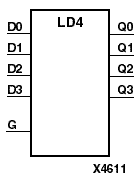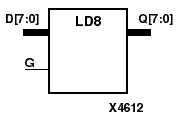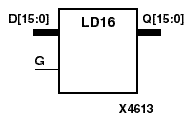| Element | XC3000 | XC4000E | XC4000X | XC5200 | XC9000 | Spartan | SpartanXL | Virtex |
|---|---|---|---|---|---|---|---|---|
| LD4, LD8, LD16 | N/A | N/A | Macro | N/A | Macro | N/A | Macro | Macro |



LD4, LD8, and LD16 have, respectively, 4, 8, and 16 transparent data latches with a common gate enable (G). The data output (Q) of the latch reflects the data (D) input while the gate enable (G) input is High. The data on the D input during the High-to-Low gate transition is stored in the latch. The data on the Q output remains unchanged as long as G remains Low.
The latch is asynchronously cleared, output Low, when power is applied. For CPLDs, the power-on condition can be simulated by applying a High-level pulse on the PRLD global net. FPGAs simulate power-on when global set/reset (GSR) is active. GSR (XC4000X, SpartanXL, Virtex) default to active-High but can be inverted by adding an inverter in front of the GSR input of the STARTUP or the STARTUP_VIRTEX symbol.
“LD”Refer to the section for information on single transparent data latches.
| Inputs | Outputs | |
|---|---|---|
| G | D | Q |
| 1 | 0 | 0 |
| 1 | 1 | 1 |
| 0 | X | No Chg |
| D | d | |
| d = state of input one setup time prior to High-to-Low gate transition | ||
Figure 7.6 LD8 Implementation XC4000X, XC9000, SpartanXL, Virtex |